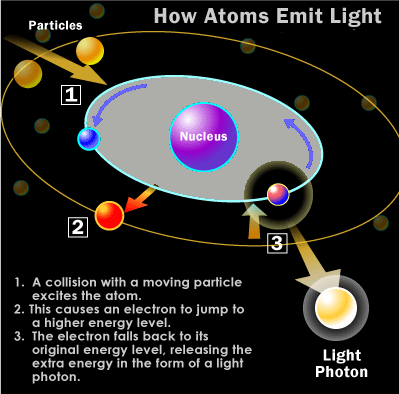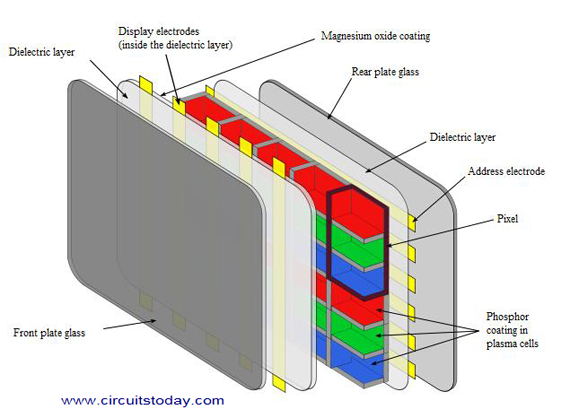The basic of any television is the Cathode Ray Tube [CRT]. We have been using this technology for the past 75 years.
But there are a lot of disadvantages for a CRT. The display lacks in clarity, and the size of the screen is huge. They become bulkier in size with the increase in screen width as the length f the tube has to be increased accordingly. This, inturn increases the weight.
Plasma display is the best remedy for this. Their wide screen display, small size and high definition clarity are their greatest advantages.
What is Plasma?
Plasma is referred to be the main element of a fluorescent light. It is actually a gas including ions and electrons. Under normal conditions, the gals has only uncharged particles. That is, the number of positive charged particles [protons] will be equal to the number of negative charged particles [electrons]. This gives the gas a balanced position.
Suppose you apply a voltage onto the gas, the number of electrons increases and causes an unbalance. These free electrons hit the atoms, knocking loose other electrons. Thus, with the missing electron, the component gets a more positive charge and so becomes an ion.
In plasma, photons of energy are released, if an electrical current is allowed to pass through it. Both the electrons and ions get attracted to each other causing inter collision. This collision causes the energy to be produced. Take a look at the figure illustrated below.

Plasma displays mostly make use of the Xenon and neon atoms. When the energy is liberated during collision, light is produced by them. These light photons are mostly ultraviolet in nature. Though they are not visible to us, they play a very important factor in exciting the photons that are visible to us.
In an ordinary TV, high beams of electrons are shot from an electron gun. These electrons hit the screen and cause the pixels to light up. The TV has three types of composite pixel colours which are distributed throughout the screen in the same manner. They are red, green and blue. These colours when mixed in different proportions can form the other colours. Thus the TV produces all the colours needed.
A plasma display consists of fluorescent lights which causes the formation of an image on screen. Like a CRT TV, each pixel has the three composite fluorescent colour lights. These fluorescent lights are illuminated and the different colours are formed by combining the composite colours.
History of Plasma Display
The first ever plasma display was made in the year 1964 by the graduate student Robert Willson for the PLATO Computer System, Donald Bitzer, and H. Gene Slottow from the University of Illinois at Urbana-Champaign. Larry F. Weber, a student from the same university was able to make an energy recovery sustain circuit for the plasma TV, which has been included in plasma displays even now.
This technology was then futher developed by many people and multi-national companies started to economize it by the early 80’s.
In the year 1983, IBM began selling a 19 inch orange-on-black monochrome display. But they stopped its production permamnently as the product had a very tough competition with monochrome LCD’s. The plasma displays in this period could not be usd as TV’s as they did not have TV tuners. They were only used to display a standard video signal.Now all the plasma TV’s have their own digital Tv tuners. The first colour plasma display was introduced in the year 1992 by the Fujitsu company. The company later released a 42 inch plasma TV in the year 1997 which had a high resolution of 852×480. This technology began to overrule the CRT revolution for the coming years. Lately, after the invention of LCD TV, the demand for Plasma TV became lesser. As the same configuration for a lesser price is available the sale of Plasma Tv became lesser.
Working of Plasma Display
Two plates of glass are taken between which millions of tiny cells containing gases like xenon and neon are filled. Electrodes are also placed inside the glass plates in such a way that they are positioned in front and behind each cell. The rear glass plate has with it the address electrodes in such a position that they sit behind the cells. The front glass plate has with it the transparent display electrodes, which are surrounded on all sides by a magnesium oxide layer and also a dielectric material. They are kept in front of the cell.
As told earlier when a voltage is applied, the electrodes get charged and cause the ionization of the gas resulting in plasma. This also includes the collision between the ions and electrons resulting in the emission of photon light.
The state of ionization varies in accordance to colour plasma and monochrome plasma. For the latter a low voltage is applied between the electrodes. To obtain colour plasma, the back of each cell has to be coated with phosphor. When the photon light is emitted they are ultraviolet in nature. These UV rays react with phosphor to give a coloured light. Take a look at the diagram given below.

The working of the pixels has been explained earlier. Each pixel has three composite coloured sub-pixels. When they are mixed proportionally, the correct colour is obtained.
There are thousands of colours depending on the brightness and contrast of each. This brightness is controlled with the pulse-width modulation technique. With this technique, it controls the pulse of the current that flows through all the cells at a rate of thousands of times per seconds.
Characteristics of Plasma Display
- Plasma displays can be made upto large sizes like 150 inches diognal.
- Very low-luminance “dark-room” black level.
- Very high contrast.
- The plasma display panel has a thickness of about 2.5 inches, which makes the total thickness not more than 4 inches.
- For a 50 inch display, the power consumption increases from (50-400) watts in accordance with images having darker colours.
- All displays are sold out in shop mode which consumes more power than the above described. It can be changed to home mode.
- Has a life-time of almost 100,000 hours. After this period, the brightness of the TV reduces to half.
Plasma TV Resolutions
The resolution of a plasma display varies from the early enhanced definition [ED], to the modern high-definition displays. The most common ED resolutions were 840*480 and 853*480.
With the emergence of HDTV’s the resolution also became higher. The modern plasma TV’s have a resolution of 1,024*1,024, 1,024*768, 1,280*768, 1,366*768, 1,280*1080, and also 1,920*1,080.
Advantages of Plasma Display
- The slimmest of all displays
- Very high contrast ratios [1:2,000,000]
- Weighs less and is less bulky than CTR’s.
- Higher viewing angles compared to other displays [178 degrees].
- Can be placed even on walls.
- High clarity and hence better colour reproduction. [68 billion/236 vs 16.7 million/224]
- Very little motion blur due to high refresh rates and response time.
- Has a life span of about 100,000 hours.
Disadvantages of Plasma Display
- Cost is much higher compared to other displays.
- Energy consumption is more.
- Produces glares due to reflection.
- These displays are not available in smaller sizes than 32 inches.
- Though the display doesn’t weigh much, when the glass screen, which is needed to protect the display, is included, weighs more.
- Cannot be used in high altitudes. The pressure difference between the gas and the air may cause a temporary damage or a buzzing noise.
- Area flickering is possible.
Some useful resources:
TAKE A LOOK : WORKING OF CRT
TAKE A LOOK : LCD vs PLASMA DISPLAY

3 Comments
Its very useful to know us…..clearly to explain about it Thank you…
Very nice information about the Plasma displays is given.But I am very sorry to say that the information about the problems seen on the Plasma displays like about 1″ disturbance band with very thin 2+2 lines found both sides of the band type disturbance,3″before the right edge of the 42″Plasma TV. Dose it a Plasma display fault or a Video circuit fault? This type of information is presently need to me,can you help me? Thanks.
BUT THIS TECHNOLOGY IS NOT NOW IN USE.
IT SHOULD BE HANDED VERY CAREFULLY.